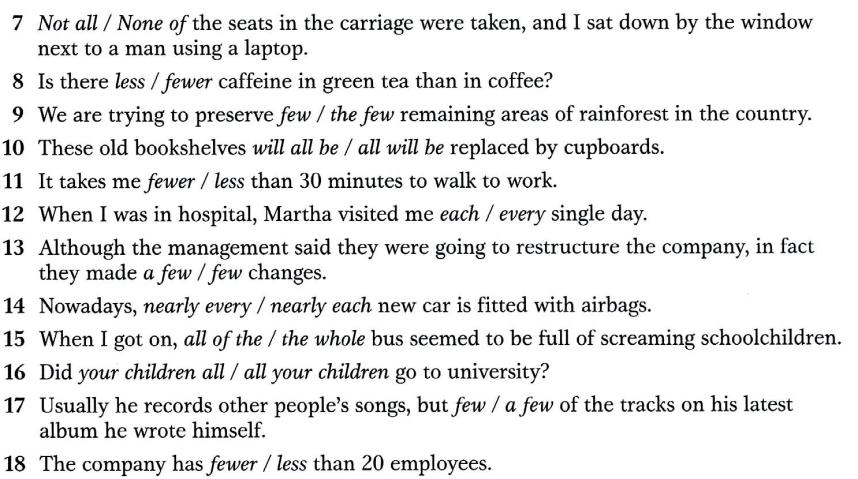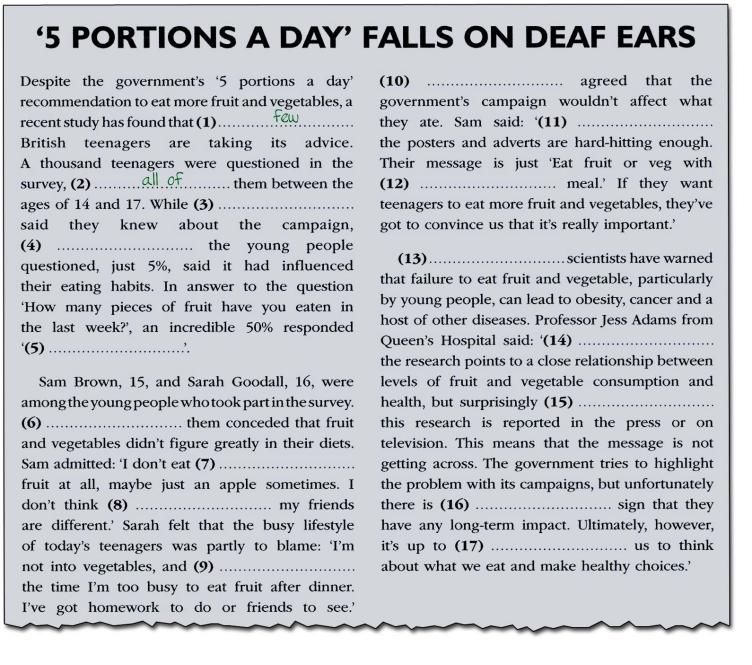
- •Seminar 6 Theoretical questions to be discussed
- •Determiners;
- •Auxiliaries (primary and modal);
- •Prepositions;
- •Adverbial particles;
- •Conjunctions (coordinators and subordinators);
- •Numerals (cardinals and ordinals). General characteristics.
- •Number of Articles
- •Exercises
- •Group out the following words:
- •Pronouns perform different functions in the sentence. Define what functions the underlined pronouns perform in the following sentences:
- •Choose the correct alternative. Sometimes both are possible.
- •Select the right word or phrase and fill in the gaps. Use each option only once.
- •Like adjectives, numerals can be substantivized. Define the nature of the underlined words in the following sentences. Prove that you are right:
- •Put the article where necessary. Explain your choice.
Choose the correct alternative. Sometimes both are possible.


2) each
3) the whole
4) little
5) both are possible
6) not all
7) both are possible
8) less
9) the few
10) both are possible
11) fewer
12) both are possible
13) a few
14) both are possible
15) both are possible
16) both are possible
17) a few
18) fewer
Select the right word or phrase and fill in the gaps. Use each option only once.


3) many
4) few of
5) none
6) both of
7) much
8) many of
9) most of
10) all
11) none of
12) every
13) many
14) much of
15) little of
16) little
17) each of
Numerals indicate either a definite number or the position in a series. Accordingly, we distinguish cardinal and ordinal numerals. Numerals can be simple, derived, and compound. Group out the following words according to the criteria below:
;;;;
|
simple |
derived |
compound |
cardinal |
Four; twenty; five; Twelve; |
Thirteen; eighteen; forty; |
sixty-nine |
ordinal |
Second; first; third; |
eleventh; tenth; |
ninety-eighth; |
Like adjectives, numerals can be substantivized. Define the nature of the underlined words in the following sentences. Prove that you are right:
1. There are hundreds among the members of this club.
2. You haven't had a single five this term. You'd better work a bit harder next term.
3. It's after four.
4. Two can play this game.
5. 24 is two dozen.
6. Now the other two got out.
7. And again she saw them, but not four, more like forty laughing, sneering, jeering...
8. He has three pens.
1. "Hundreds" is a substantivized numeral. It functions as a noun, representing a large quantity of something. It is the subject of the sentence, indicating a specific count of members in the club.
2. "Five" is substantivized numerals. "Five" functions as a noun, representing a specific grade. It is the objects of the verb "had", indicating a lack of occurrence of a specific grade.
3. "Four" is a substantivized numeral. It functions as a noun, representing a specific time. It is the object of the preposition "after", indicating a specific point in time.
4. "Two" is a substantivized numeral. It functions as a noun, representing a specific number of individuals. It is the subject of the sentence, indicating the number of individuals who can participate in the game.
5. "Two" and "dozen" are both substantivized numerals. "Two" functions as a noun, representing a specific quantity. "Dozen" functions as a noun, representing a specific quantity. They are the subject and predicate nominative of the sentence, indicating a specific quantity.
6. "Two" is a substantivized numeral. It functions as a noun, representing a specific number of individuals. It is the subject of the sentence, indicating the number of individuals who got out.
7. "Four" and "forty" are both substantivized numerals. "Four" functions as a noun, representing a specific quantity. "Forty" functions as a noun, representing a specific quantity. They are the objects of the preposition "not", indicating a specific count of individuals.
8. "Three" is a substantivized numeral. It functions as a noun, representing a specific quantity of items. It is the subject of the sentence, indicating the quantity of pens.
Cardinal numerals are used in the function of subjects, predicatives, objects, adverbial modifiers and attributes (appositions). As a rule ordinal numerals are used as attributes. But they may also be used as subjects, predicatives and objects. Define the functions of the underlined words in the following sentences:
“No, this is my first dance,” she said.
"First" functions as an adjective modifying the noun "dance".
Earle Fox was only fifty-four, but he felt timeless and ancient.
"Fifty-four" functions as an adjective modifying the noun "Earle Fox".
And again she saw them, but not four, more like forty laughing, sneering, jeering...
"Four" and "forty" both function as adjectives modifying the implied noun (e.g., people, individuals).
Then, advancing obliquely towards us, came a fifth.
"Fifth" functions as an adjective modifying the implied noun (e.g., person, figure).
Almost immediately the band started and her second partner seemed to spring from the ceiling.
"Second" functions as an adjective modifying the noun "partner".
Four men in their shirt-sleeves stood grouped together on the garden path.
"Four" functions as an adjective modifying the noun "men".
And he remembered the holidays they used to have, the four of them…
"Four" functions as an adjective modifying the implied noun (e.g., people, individuals).
Sooner or later, someone is going to tell you about that damned river, so I might as well be the first.
"First" functions as an adjective modifying the implied noun (e.g., person, one).
...the young man opposite had long since disappeared. Now the other two got out.
Two functions as a pronoun referring to a previously mentioned group or pair.
At eight the gang sounded for supper.
Eight functions as an adverb modifying the verb ‘sounded.
..she noted a scar on his cheek, another that peeped out from under the hair of the forehead, and a third that ran down and disappeared under the starched collar.
"Third" functions as an adjective modifying the implied noun (e.g., scar, mark).
